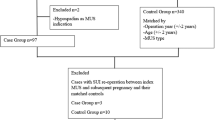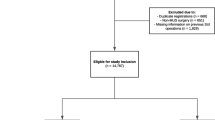Abstract
In this article, the effects of pregnancy and delivery on the development of stress urinary incontinence are described with special emphasis on the obstetrical management in women who wish to become pregnant or are pregnant after a preceding mid-urethral sling procedure. Three case histories and a review of literature are presented. Pregnancy after a preceding incontinence operation is rare and makes it quite difficult to formulate guidelines about delivery when a pregnancy occurs. The best advice is to postpone incontinence surgery until after the last pregnancy. There is evidence that an elective caesarean delivery protects against stress urinary incontinence in case of pregnancy after bladder neck suspension. For mid-urethral sling procedures, this evidence is not available. The presented case reports do not clearly demonstrate that caesarean delivery is necessary in case of pregnancy and delivery after a mid-urethral sling procedure. Furthermore, a second mid-urethral sling operation is a minor procedure compared to a caesarean section, and there is evidence that a second mid-urethral sling operation has the same success rate as the first procedure.
Similar content being viewed by others
References
Hannestad YS, Rortveit G, Sandvik H, Hunskaar S (2000) A community-based epidemiological survey of female urinary incontinence: the Norwegian EPINCONT Study. Epidemiology of incontinence in the county of Nord-Trondelag. J Clin Epidemiol 53:1150–1157
Rekers H, Drogendijk AC, Valkenburg H, Riphagen F (1992) Urinary incontinence in women from 35 to 79 years of age: prevalence and consequences. Eur J Obstet Gynecol Reprod Biol 43:229–234
van der Vaart CH, de Leeuw JR, Roovers JP, Heintz AP (2000) [The influence of urinary incontinence on quality of life of community-dwelling, 45–70 year old Dutch women]. Ned Tijdschr Geneeskd 144:894–897
Rortveit G, Hannestad YS, Daltveit AK, Hunskaar S (2001) Age- and type-dependent effects of parity on urinary incontinence: the Norwegian EPINCONT Study. Obstet Gynecol 98:1004–1010
Seeger D, Truong ST, Kimmig R (2006) Spontaneous delivery following tension-free vaginal tape procedure. Int Urogynecol J Pelvic Floor Dysfunct 17:676–678
Dainer M, Hall CD, Choe J, Bhatia N (1998) Pregnancy following incontinence surgery. Int Urogynecol J Pelvic Floor Dysfunct 9:385–390
Vierhout ME (23-7-2005) [Increase in number of operations for stress urinary incontinence]. Ned Tijdschr Geneeskd 149:1704–1706
Keane DP, Sims TJ, Abrams P, Bailey AJ (1997) Analysis of collagen status in premenopausal nulliparous women with genuine stress incontinence. Br J Obstet Gynaecol 104:994–998
King JK, Freeman RM (1998) Is antenatal bladder neck mobility a risk factor for postpartum stress incontinence. Br J Obstet Gynaecol 105:1300–1307
van Brummen HJ, Bruinse HW, van der Bom JG, Heintz AP, van der Vaart CH (2006) How do the prevalences of urogenital symptoms change during pregnancy. Neurourol Urodyn 25:135–139
Dietz HP, Lanzarone V (2005) Levator trauma after vaginal delivery. Obstet Gynecol 106:707–712
Snooks SJ, Swash M, Henry MM, Setchell M (1986) Risk factors in childbirth causing damage to the pelvic floor innervation. Int J Colorectal Dis 1:20–24
Viktrup L, Lose G (2001) The risk of stress incontinence 5 years after first delivery. Am J Obstet Gynecol 185:82–87
Smith AR, Hosker GL, Warrell DW (1989) The role of partial denervation of the pelvic floor in the aetiology of genitourinary prolapse and stress incontinence of urine. A neurophysiological study. Br J Obstet Gynaecol 96:24–28
Allen RE, Hosker GL, Smith AR, Warrell DW (1990) Pelvic floor damage and childbirth: a neurophysiological study. Br J Obstet Gynaecol 97:770–779
van Brummen HJ, Bruinse HW, van de PG, Heintz AP, van der Vaart CH (2006) Bothersome lower urinary tract symptoms 1 year after first delivery: prevalence and the effect of childbirth. BJU Int 98:89–95
van Brummen HJ, Bruinse HW, van de PG, Heintz AP, van der Vaart CH (2007) The effect of vaginal and cesarean delivery on lower urinary tract symptoms: what makes the difference? Int Urogynecol J Pelvic Floor Dysfunct 18:133–139
Dwyer PL, Lee ET, Hay DM (1988) Obesity and urinary incontinence in women. Br J Obstet Gynaecol 95:91–96
Mommsen S, Foldspang A (1994) Body mass index and adult female urinary incontinence. World J Urol 12:319–322
Rortveit G, Daltveit AK, Hannestad YS, Hunskaar S (2003) Urinary incontinence after vaginal delivery or cesarean section. N Engl J Med 348:900–907
Iskander MN, Kapoor D (2000) Pregnancy following tension-free vaginal taping. Int Urogynecol J Pelvic Floor Dysfunct 11:199–200
Lynch CM, Powers AK, Keating AB (2001) Pregnancy complicated by a suburethral sling: a case report. Int Urogynecol J Pelvic Floor Dysfunct 12:218–219
Gauruder-Burmester A, Tunn R (2001) Pregnancy and labor after TVT-plasty. Acta Obstet Gynecol Scand 80:283–284
Vella M, Robinson D, Brown R, Cardozo L (2007) Pregnancy and delivery following tension-free vaginal tape. Int Urogynecol J Pelvic Floor Dysfunct 18:347–348
Hassan MS, Yossri N, Davies A (2007) Vaginal delivery after surgical treatment for stress incontinence using transobturator tape: a case report. BJOG 114:113–114
Panel L, Tayrac R de, and Mares, P (2006) Pregnancy following surgical treatment of stress urinary incontinence using vaginal tapes. Results of a French national survey. Proceedings IUGA Annual Meeting, Athens, abstract 064
Cutner A, Cardozo LD, Wise BG (1991) The effects of pregnancy on previous incontinence surgery. Case report. Br J Obstet Gynaecol 98:1181–1183
Amaye-Obu FA, Drutz HP (1999) Surgical management of recurrent stress urinary incontinence: a 12-year experience. Am J Obstet Gynecol 181:1296–1307
Petrou SP, Frank I (2001) Complications and initial continence rates after a repeat pubovaginal sling procedure for recurrent stress urinary incontinence. J Urol 165:1979–1981
Rezapour M, Ulmsten U (2001) Tension-free vaginal tape (TVT) in women with recurrent stress urinary incontinence—a long-term follow up. Int Urogynecol J Pelvic Floor Dysfunct 12(Suppl 2):S9–S11
Riachi L, Kohli N, Miklos J (2002) Repeat tension-free transvaginal tape (TVT) sling for the treatment of recurrent stress urinary incontinence. Int Urogynecol J Pelvic Floor Dysfunct 13:133–135
Viktrup L (2002) The risk of lower urinary tract symptoms five years after the first delivery. Neurourol Urodyn 21:2–29
Hurt WG (1991) Selection of surgical. procedure for the treatment of stress urinary incontinence. In: Ostergard DR, Bent AE (eds) Urogynecology and urodynamics: theory and practice, 3rd edn. Williams & Wilkins, Baltimore, p 468
Rezapour M, Ulmsten U (2001) Tension-free vaginal tape (TVT) in women with recurrent stress urinary incontinence—a long-term follow up. Int Urogynecol J Pelvic Floor Dysfunct 12(Suppl 2):S9–S11
Glazener CM, Herbison GP, MacArthur C, Grant A, Wilson PD (12-2-2005) Randomised controlled trial of conservative management of postnatal urinary and faecal incontinence: six year follow up. BMJ 330:337
Lydon-Rochelle M, Holt VL, Easterling TR, Martin DP (5-7-2001) Risk of uterine rupture during labor among women with a prior cesarean delivery. N Engl J Med 345:3–8
Tunn R (2006) Childbearing after TVT: how I have my baby when I have a TVT. Int Urogynecol J Pelvic Floor Dysfunct 17:553–554
Acknowledgments
We thank Dr Dorette Courtar of University Hospital Maastricht for the synopsis of pregnancy and labor of the third patient.
Conflicts of interest
None.
Author information
Authors and Affiliations
Corresponding author
Rights and permissions
About this article
Cite this article
Groenen, R., Vos, M.C., Willekes, C. et al. Pregnancy and delivery after mid-urethral sling procedures for stress urinary incontinence: case reports and a review of literature. Int Urogynecol J 19, 441–448 (2008). https://doi.org/10.1007/s00192-007-0509-3
Received:
Accepted:
Published:
Issue Date:
DOI: https://doi.org/10.1007/s00192-007-0509-3




